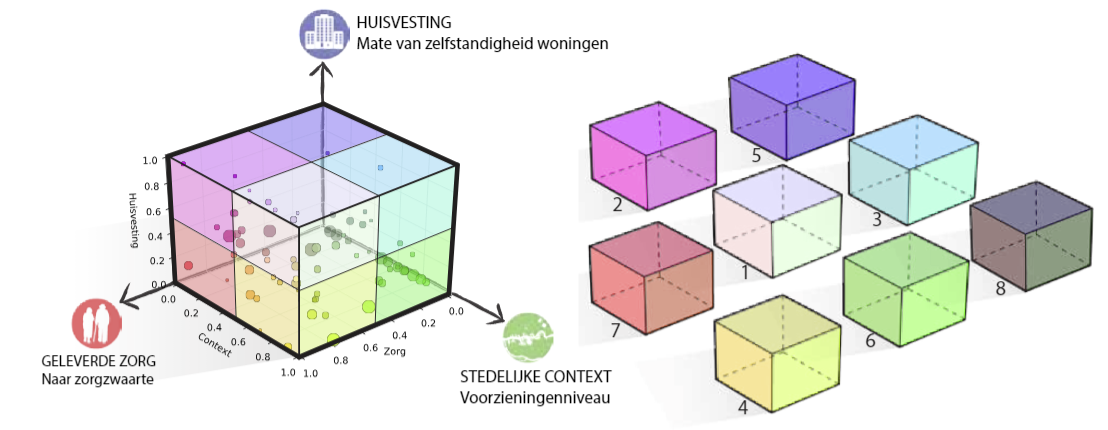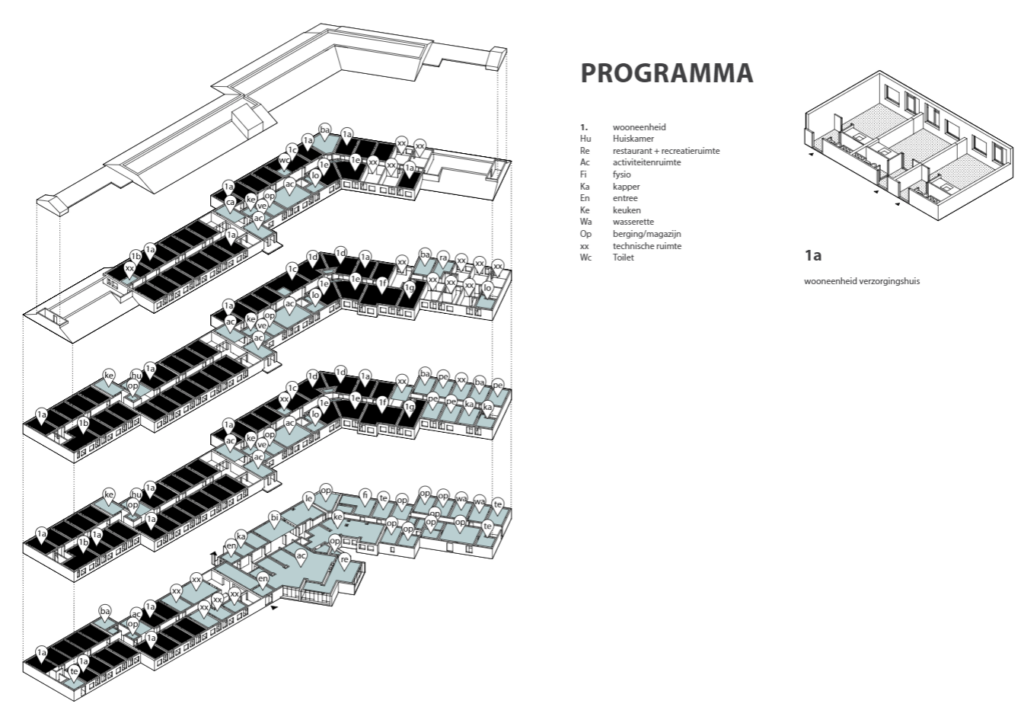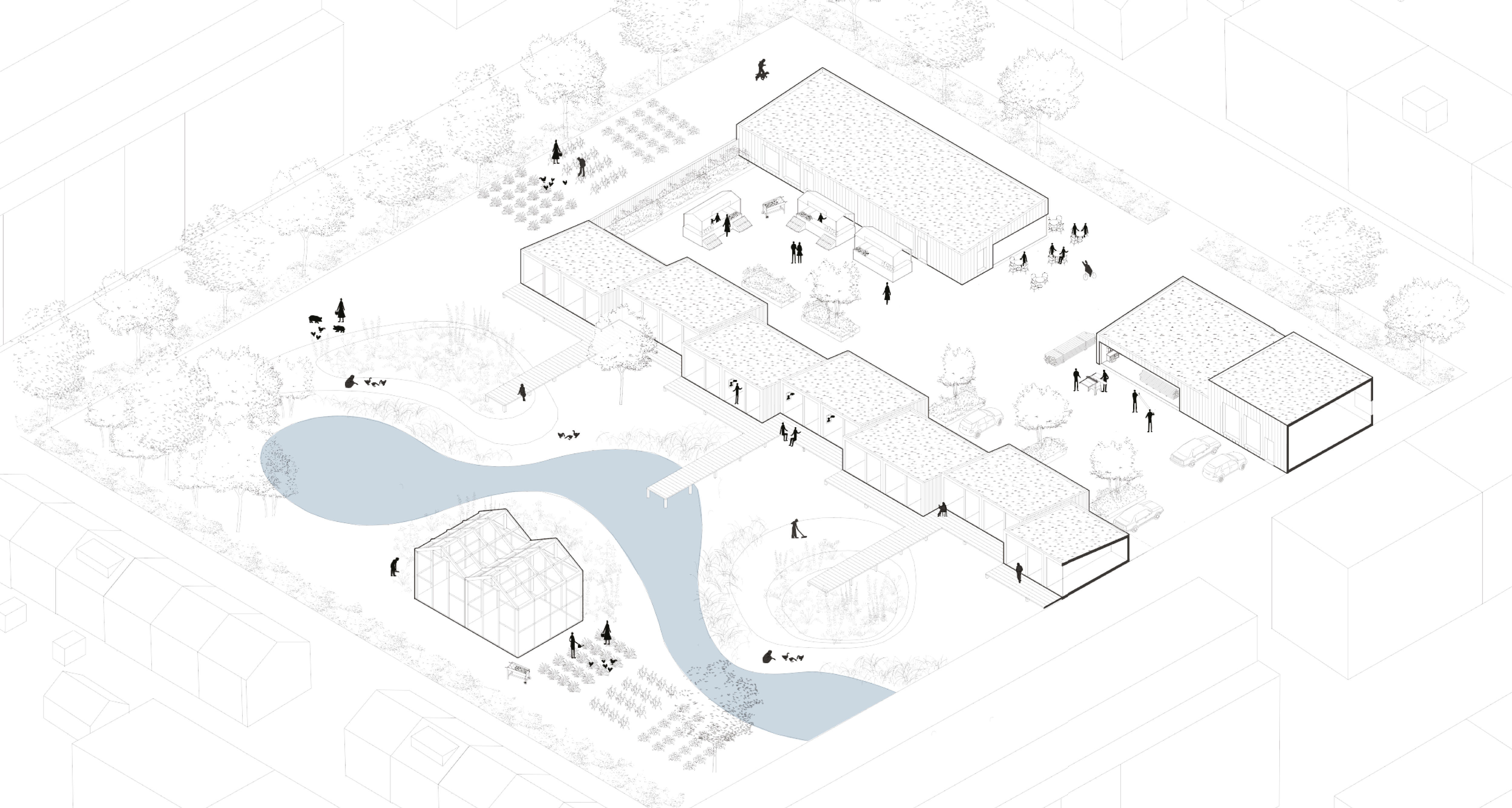
Study and strategy for the implementation agenda (2024-2034) Housing, Care and Well-being for elderly in Amsterdam and region
Amsterdam, NL | 2023 – | in execution| urban planning, health care housing | research & design strategy | Gemeente Amsterdam | partner: Veldacademie
In 2015, a change took place in the way in which care for vulnerable groups is organized in the Netherlands: with decentralization, the government transferred responsibility for care for the long-term ill and the elderly to municipalities. Where previously the national government determined which care was purchased, this is now up to the local government and the regional care office. The separation of housing and care has led to different ways of financing and organizing . All this from the perspective of allowing elderly adults and other people with the needs of care to live independently at home for a longer time. Healthy aging in place. This idea wrongly suggests that intramural care homes lose their significance. Existing locations often play an important role in facilitating this ‘aging in place’ and participation in the neighborhood. How should housing and care for special target groups be designed?
The question, at the time as a result of decentralization but also today due to demographics (aging society + double aging) and pressure on both the housing market and healthcare, is what role residential care locations can (continue to) play in the housing of elderly people with need for care. This question is not only important for real estate owners and healthcare providers. The locations play a role in the range of services, facilities and activities for local residents in a broad sense. While the ‘aging in place’ development on the one hand leads to a reduction in places in intramural homes, on the other hand this potentially increases the significance of these homes for elderly people living in the surroundings. This applies not only to the range of activities and facilities on offer, but also to the maintenance of informal care networks. A weighted distribution of affordable locations across the city so that elderly people can continue to participate within their network – and informal care can be exchanged – is therefore important.

In order to make well-considered and substantiated choices about the development of existing and new residential care locations for the elderly, a good knowledge position is required. On behalf of the municipality of Amsterdam and in collaboration with healthcare providers, corporations, city districts, healthcare office and SIGRA, Veldacademie has been carrying out a periodic inventory of the city-wide network of care homes since 2014. The first inventory of ‘Zicht op Zorghuisvesting‘ Amsterdam (View of Healthcare Housing) was completed at the end of 2015. An update followed in 2018 with the aim of monitoring the development of the locations. An update of the urban inventory was started in 2023. This time expanded with a design study into possible development locations for real estate and residential service areas (called residential care circles or ‘woonzorgcirkels’). A scale jump is also being made to the region around Amsterdam, and the domains of mental health care, youth care and care for the disabled are being added.
The current study is being carried out in the context of the Amsterdam implementation agenda for housing, care and well-being for the elderly (2024-2034), on which the municipality, housing associations, the regional care office, healthcare organizations, umbrella organizations and interest groups are working together. This agenda answers to the question of how assisted living and aging in place for elderly people in need of care should be implemented in concrete terms: what is available in terms of nursing homes, collective homes, care and welfare services and what is the need/demand?
Such an implementation agenda does not come about easily. The task is complex because living,
welfare, healthcare, city government and local districts must be brought together. Interests of the municipality,
the regional healthcare office, healthcare providers, social organizations, housing corporations, private investors and tenants or clients do not always run parallel. On behalf of the municipality of Amsterdam and together with Veldacademie and the local stakeholders as mentioned above we are working on elaborating the steps in the road map, in order to arrive at a concrete implementation agenda that is in line with the Amsterdam situation.
The study and process guidance consists of the following components:
- Inventory of current situation + selection of development locations
The aim of making an urban inventory of all nursing locations for the elderly is to establish a common knowledge position to discuss the future of healthcare housing in Amsterdam. We map out the condition of the existing intramural real estate for approximately 60 locations, the current development plans for this real estate and the potential for expansion with clustered (care-suitable) homes for the elderly and possible further development into a residential care circle. In a residential care circle, a central meeting place (walk-in location or 24-hour care location) forms the core. Around this core, people who need care or support live independently in the neighborhood.
From the long list of 60 locations, 10 locations are selected where there are the most opportunities for an appropriate transformation of healthcare real estate and/or the realization of adaptable homes,
clustered homes, homes suitable for care, nursing home places on the plot or in the
proximity, mixed living arrangements and residential care circles.
- Design research
The 10 selected locations are included in the existing area development plans or provide a reason to start an area development. The inquiry will be examined in more detail, with a specification of the numbers of homes, surface areas and starting points. This allows a broadly supported assignment to be formulated for potential implementing parties. Through design research, the puzzle of target groups, locations, care, welfare and bricks is put together. In this co-creation process, relevant actors are involved at an early stage who can support and implement a location development.
In concrete terms, the study and associated process should lead to renovated nursing homes and additional ones (care-suitable) homes for the elderly with meeting areas, in which vulnerable residents receive as much support as possible from caring neighborhoods and have to rely as little as possible on formal care. This allows a growing target group to live independently at home for longer in the city.
In the period 2014 – 2017, Veldacademie carried out the same inventory for the municipality of Rotterdam in the sectors elderly care, mental health care and care for the disabled. Following the urban inventories, design research was carried out at ten locations to explore development options at building and district level. Part of the research included design workshops with healthcare institutions, residents and welfare parties in the neighborhood.


